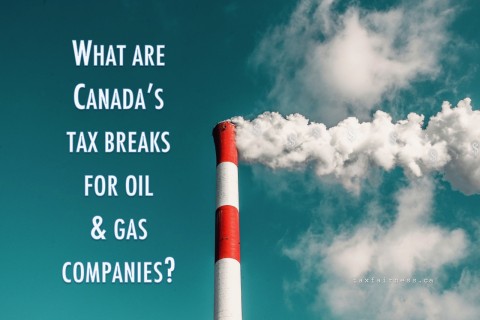
To fight costly climate change, Canada needs to quickly transition toward a sustainable economy with low-emission energy sources. The tax system has an enormous influence on this transition. Currently, our tax system is not helping that transition move quickly. Instead, Canadian governments subsidize the fossil fuel industry to the tune of $4.8 billion per year. Making our climate tax policies effective should involve ending tax incentives for carbon polluters, increasing the price on pollution, improving transparency on public subsidies to fossil fuels, and taxing high-emission imports.
HOW DOES CANADA SUBSIDIZE OIL & GAS?
A large portion of Canada’s subsidies for oil & gas are delivered via significant tax breaks for fossil fuel producers and large carbon emitters. These breaks take on many forms, such as lower carbon tax rates, reductions on crown royalties, tax credits for infrastructure, and support for research & development.
Reductions on crown royalties: Reductions on crown royalties allow fossil fuel companies to pay less in royalties for drilling and mining on crown land. Used mainly in Alberta, these reductions are valued at $1.16 billion in that province alone.
Infrastructure tax credits: Infrastructure tax credits support fossil fuel companies to build pipelines and deep-drilling sites. In BC alone, over $72 million was handed out in just a two year span to 21 fossil fuel companies.
Tax loss carryforward: A tax loss carryforward is an amount of money that a company or individual can use to offset and eliminate the tax they owe each year. The oil and gas industry has an estimated tax loss carryforward of approximately $63 billion! So even while these companies are still making money, they are using their carryforward to avoid paying taxes.
Preferential carbon pricing treatment: Further, the oil & gas sector receives preferential treatment under Canada’s carbon pricing system with the justification that it must remain internationally competitive. However, this just keeps fossil fuel companies excessively profitable, as they have been for decades.
Significant investment: While giving these tax breaks, the government has also invested at least $45 billion into the fossil fuel industry since early 2020 alone - almost $1,200 per Canadian.
WHAT PROGRESS HAS BEEN MADE?
While Canada’s fossil fuel industry eats up an outsized portion of the global carbon budget, an OECD scorecard ranked Canada last of 11 G20 countries in terms of its high support for the fossil fuel industry and in its progress toward ending support for fossil fuel.
The Liberal government has set a timeline to transition to a low-carbon economy by 2030 and eventually into a net-zero emission country by 2050 [1]. It has made several relevant promises, but so far only reformed a handful of regressive tax measures that incentivise fossil fuel production and use.
Budget 2022 committed to eliminating flow-through shares that entice investment in oil & gas companies by lowering the tax bills of investors. This is a welcome policy change, but not enough. We need to act faster.
WHAT NEEDS TO BE DONE?
Here are some tax strategies the government can implement now, to expedite the process toward net-zero emissions:
- Phase out tax incentives for oil and gas companies - mainly fossil fuel subsidies. Reintroduce those incentives for green companies instead.
- Increase the price on pollution and non-renewable energy use by using tools like the carbon tax
- Improve transparency in reporting tax expenditures; specifically, a public report detailing fossil fuel subsidies, as per the G20 agreement [2] and 2019 Mourneau Mandate.
- Implement a carbon tariff on high-emission imports and place the carbon tax on all domestic high emission industries.
ENDNOTES
[1] Liberal Party election platform, 2019
[2] International Best Practices: Estimating tax subsidies for fossil fuels in Canada, Report by the International Institute for Sustainable Development, December 2020.
Regarding investments: The government can also phase out investment in the fossil fuel industry, and invest in training programs for transitioning non-renewable energy workers to renewable, sustainable jobs. According to the IISD, the money used for fossil fuel subsidies could fund the training of at least 480,000 workers to support green energy production.
